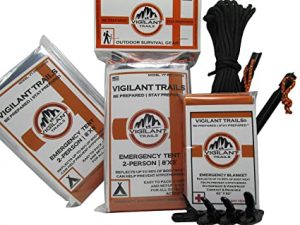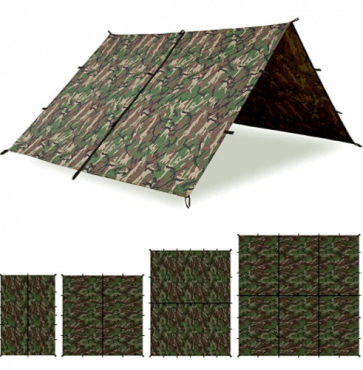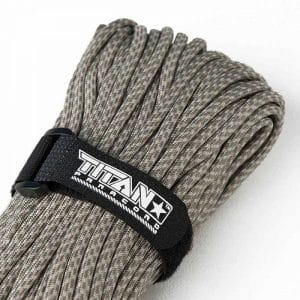In the wilderness, away from the civilization, survival shelters are must-haves: it will save you from a desert wind, tropical rains, heat, and cold of a polar night in the snow of the North.Our article will walk our readers through the essentials concerning survival shelters, their building, finding, insulation tips, crucial gear, and tools to have with you to survive in any situation.
Here we provide you a way to find the most useful information on finding, building, and deploy survival shelters in the wilderness on our website.
Why Learn How to Build a Survival Shelter
Anyone who loves a good outdoors trip also knows the importance of having a roof over your head and a wall to protect you from sudden animal attacks. Many people get tricked by modern technology we have access to nowadays into thinking that they can overcome anything that comes their way. But be aware, even when it seems as if you have everything under control — checked the weather forecast, got supplies, necessary tools to build a home, a survival bunker, or a fire, warm clothes — nature might throw another unpleasant surprise at you.
Surviving in the wild is not easy. If you have some budget – consider a commercial solution – luxury underground bunker. On the contrary, it is dangerous, challenging, and full of unexpected and strange things that one cannot control. Whether you are planning on having a civilized hike, a wilderness bug-out, or a homesteading, you should always be equipped and prepared for unorthodox situations. Thus, preparing for a camping trip, do not forget to take care of your future temporary home.
One should also know that no shelter is suitable for any environment and weather conditions. While some are good for protection against heat waves, others turn out to be most effective during blizzards. Consider getting decent poncho shelter for your needs. Roughly, all the wilderness survival shelters might be divided into the following types:
- Snow Survival Shelter;
- Forest Survival Shelter;
- Desert Survival Shelter;
- Jungle Survival Shelter.
Introducing Survival Shelters
This piece offers you emergency survival guidelines and shelter building principals and techniques required for a successful wilderness survival experience. If you are keen on hiking, enjoying the fresh air, and getting in touch with nature, this article is definitely worth your attention. Here you may get acquainted with different types of survival shelters prepared for any weather conditions. Further on, you will get a unique opportunity not only to understand how to design a proper survival shelter but learn how to build one yourself. We will provide you a brief review of the most common and well-adjusted shelters, including:
- Simple Tarp Shelter and its variations;
- Debris Survival Shelter;
- Spider Survival Shelter;
- Ultimate Wickiup;
- Survival Hut;
- Snow Cave and Igloo;
- Juniper Tree Shelter.
Check out more useful tips on building underground survival bunkers on our website.
ADVERTISEMENT: You may get an ultimate preppers checklist for free by just leaving your email.
Vital Survival Tools

Moving forward, we’d like to make sure you are equipped with all the vital shelter tools when faced with the wild. Experienced long term campers know that an emergency is the hardest thing to deal with. Two parameters matter when dealing with emergencies: 1) this is an unexpected situation; 2) you must act immediately.
There is no right for a mistake in survival, so make sure you have all the best everyday carry on you. Proper equipment is required to build a survival shelter or a survival tarp. Get survival glow sticks – they last long enough to make a purpose of using. One of the most common wilderness shelter types all over the globe is a tarp. Storing a quality tarp in your bug-out vehicle or your bug out bag comes in handy when you need an easy convertible roof over your head.
We highly recommend you take a look at the 100 percent waterproof Aqua Quest Defender Tarp. Besides its versatile capacity to be set up in almost any situation, it is light, compact, yet very durable in use.



ADVERTISEMENT: On our website, you can order an exclusive bug out bag checklist for free.
Snow Shelters
Snow Cave and Igloo
Let us start by reviewing some shelters designed for winter environments. Snow can make survival hard sometimes as well. The thing about shelters is that they do not work in deep snow, so one must consider it. If there is a thick enough layer of snow, you may not be able to find any trees and sticks to build the forest shelter mentioned above.
Therefore, you have got to take maximum advantage of the snow itself as a constructing material. Snow caves serve very well as emergency shelters. To build a snow cave, all you need to do is, basically, dig a hole in the snow and get inside. It is quick, simple, safe, and enough to keep you warm. Your body heat will warm up the air space around you, and the temperature will gradually rise. A snow cave also deals well with heat protection during a blizzard.
However, despite all the simplicity and convenience of the method, there are several things you need to be aware of constructing such a shelter. Make sure you stay dry at all times because sweat combined with cold can lead to hypothermia fast. One should also be careful while cooking in a snow cave shelter. Several deaths among climbers have been reported over the past few years due to poisoning by carbon monoxide.
Another useful snow shelter for a long term stay in winter is an Igloo. It is a frame round shape shelter with walls and a roof made of ice cubes in plain words. An igloo is an iconic shelter due to its ability to last and its heat retention capacity. The more the ice melts, the more sustainable your igloo will get.
Variability of a snow frame shelter is a quinzhee. It is a dome-shaped temporary snow shelter. To construct a quinzhee, you need to make up a large pile of snow to fit a person in and make it hollow inside. Some make a little hole at the rooftop of the quinzhee to let the air circulate. The main difference between a quinzhee and an igloo is that it’s primarily made of snow rather than ice.
Snow survival skills cover much more than just building an igloo, a snow cave, or a quinzhee. To manage the snow well, take a look at our cold weather survival guide.
Forest Shelters
Tarp Survival Shelters

When dealing with a wilderness emergency, you should first of all think of survival shelters that will keep you safe and sound. First up, we would like to give a quick review of the forest type survival shelters. A tarp is the most common solution for a prolonged stay in the forest. There are various ways and techniques to set up a tarp shelter. Before we get to them, a quick reminder: always mind that you’ve got to save precious calories and time.
Some tarps come with a frame, and some don’t. A-frame is designed to maintain your tarp’s shape, so use it according to the instructions and put it up straight so that it wouldn’t lean to either side. For installing the tarp that comes without a frame, you may use two trees standing close enough together. Just tie one end of the tarp to one tree and the other to the second. Those two trees will create a tip shape for your tarp.
If you happen to have a bit more time on your hands, try to choose a better base location for your future shelter. Let the natural habitat work for you. To pick the right location, you need to identify the prevailing wind direction. The wind is usually blowing from West to East in most parts of the United States. The back of your tarp shall be facing towards the west. Thus, the tarp will stop the incoming wind and raindrops. The rule applies to most shelters and not just a tarp one. Below you will find an instruction on putting together a quality tarp shelter.
There is great variability of tarps, including a tarp wing, a tarp burrito, and a wedge tarp. For stealth camping, we advise you to take a look at the suggestions in the video instruction below. It will teach you the important skill for situations when you need to build a tarp shelter from scratch. A forest has one strong advantage — it has plenty of trees, which, in turn, provide lots of building materials, like sticks, logs, pine straws, and leaves. But leave it for the worst-case scenario.
As you may have noticed, the main purpose of tarp shelters (the tarp wing, tarp burrito, and the wedge tarp) is to keep you warm and dry, in other words, to protect you from the cold, wind, and rain. However, not all tarps fulfill that purpose equally well. Investing in a quality tarp, you are investing in your safety because:
- cheap tarps do not have grommets (which means less variability for your specific survival situation);
- non-quality grommets some cheap tarps have will rip the shelter apart under a bit of tension;
- non-quality tarps are more likely to deteriorate under ultraviolet rays.
Debris Survival Shelter
The next best thing to do in the absence of the is a debris survival shelter. Natural shelters might not be the most sophisticated ones, but they are often underestimated. To build a survival shelter like this, you need to identify an area that would be naturally protected from the wind and the rain. It is even possible to build debris in a tree provided you can find an appropriate lean-to.
If there is an empty debris hut nearby by a happy coincidence, use it instead of wasting your time and strength on building a whole new one. But if not, use all the natural resources and elements the forest and its trees can give: sticks, logs, leaf litter, etc.
ADVERTISEMENT
Provided you have the tools, the right knowledge, and some practice; you will be able to make a perfect shelter. The necessary tools minimum consists of a good survival knife, a high-quality survival hatchet, a survival machete, a portable tactical shovel. The Sportsman Pocket Chainsaw would make a great and useful addition to that list.
Ultimate Wickiup
Wickiup shelters are more complicated and time-consuming. Suitable for a long-term stay, they can fit larger groups of people. But if you plan to stay for the long term, it is reasonable to put a greater effort into making it a cozy and safe temporary home. You can build a fire to keep everybody warm. You can put together a lean-to to create additional space so that everybody feels not only safe but comfortable.
The next series of videos is dedicated to creating an ultimate wickiup and making your experience a bit less about survival and a bit more about enjoyment.
Spider Survival Shelter
Another debris shelter modification is a spider survival shelter. Among other shelters, it has a relatively simple design and, most importantly, proven by many people. It basically is a debris shelter itself but with some extra space in the front large enough for a person to sit up. This one will be perfect for a person on a medium or long term solo hike.
To learn how to build at least a mediocre spider shelter, we suggest watching a video series we have put together to make your job way easier. While building a spider shelter, take care of the small things that will make you temporary home cozier, like a sleeping bag, a wall lean-to for building a fire, and a couple more debris layers for safety and comfort.
Desert Shelters
Juniper Tree Shelter

Survival in a desert is hard in itself. It takes savvy and a particular set of skills to make an emergency shelter in a desert. You are very mistaken if you believe that no shelter is needed in a desert. Deserts get cold at night compared to the day temperatures. For instance, the winter temperatures drop into 30 degrees Fahrenheit in the sadly known “Death Valley” in California. Moreover, a survey has proven that it is at least a 27.5-degree difference between the temperature in the direct sunlight and the shade. In these circumstances, try to keep your body temperature steady.
While it is boiling in the daytime, you need to come up with a method to save you from the heat. But on the other hand, do mind the cold night temperatures. If your car broke down and you ended up in a desert, you can use the vehicle as a shelter. Most desert emergency survival scenarios prove that it is best not to leave your car at all and wait for help to come. If you, for some reason, are stranded in a desert on foot, you are definitely going to need a tarp.
Having one with you would be a great advantage and make things noticeably easier for you. But if you do not have one, then you will have to use the surroundings. Almost any desert has juniper trees that spread for miles all over the place. Use those trees and sagebrush to build into a shelter.
Another long term shelter suitable for a desert environment is a dugout shelter. It takes quite some time to build but is proven to be rather good and comfortable for a deserted area. A shovel and a lot of water are required for this one. Make sure you do not suffer from dehydration. Picking out the location watch for floods. They are very dangerous and tricky in the desert.
We highly recommend you to get our ultimate survival gear checklist. Lease your email address, and we will send it right back to you.
Jungle Shelters
Survival Hut
Having to survive in the jungle, better go with a tarp shelter. It would be more convenient to bring a tarp with you, but you can always build it with your own hands. The trees and thus, the materials would be different from the forest, but the technique is the same. This section will be about our all-time favorite long-term emergency shelter — the survival hut. The jungle provides you a unique environment for constructing this shelter. It offers large leaves, thick vines and quite often made of clay and water.
Building a proper survival hut shelter is based on using the so-called wattle and daub technique. First things first, look around and search for sticks and shoots. Then interlace them with each other to create a fence-like structure. Use the clay soil to put on top of the fence and let it dry. As a result, you’ll get a wall which you can later use to put the whole hut together. This is another great example of how to build an emergency shelter using almost no tools. Take a look at the possible suggestions on using this primitive and yet proven technology to put together survival shelters in the wild jungle.
Survival Action Plan Guidelines
Now that you have all the necessary skills to ensure your life and safety in the wilderness, it is about time to get a company and plan a bug-out trip. Whatever the environment, weather forecast, or survival situation, you will know how to build an emergency shelter on your own. For your own safety, try to choose the locations closer to home and emergency services, because impressions are great, views are beautiful, but the most important thing is your life. And remember that only practice makes it perfect. Do not be afraid to make some mistakes along the way, but safety should always come first.
To sum up, in preparation for your adventure, make yourself a survival checklist and get all the necessary survival gear: a high-quality tarp, a good paracord, and some tact bivy.
Additionally, you can create your very own car emergency kit from scratch and stash some day packs, tools to build a fire, a couple of sleeping bags, a self-made get home bag, and a bug out bag in your vehicle. With these in place, you will be able to adapt to any circumstances and overcome any challenge that comes your way.

FAQs
How do you build an outdoor survival shelter?
Building an outdoor survival shelter requires a particular set of skills and tools. That is why it is so important to go into the wilderness well-prepared. To choose a way to build an outdoor survival shelter, you need to get acquainted with the surroundings first. Depending on the weather conditions, you can build a tarp, a frame shelter, debris, a spider hut, a dugout, a wickiup, a juniper tree shelter, a snow cave, a quinzhee, or an igloo. Use all the building elements nature provides you with.
What is a survival shelter?
A survival shelter is, basically, a temporary bug out of a home that serves to keep you safe from the cold, rain, wind, blizzard, sand storm, heat, and many other meteorological factors. Survival shelters serve as protection against the unexpected dangers that might occur away from civilization.
How do you build a shelter in the woods with no tools?
If you are stranded somewhere in the wild and do not happen to have any tools with you, use the natural elements as building materials. Every environment has its unique conditions and, therefore, a different building base to use. Leaves, sticks, and logs may be put together into debris. The jungle provides various vines and shoots to weave together into a fence wall, and the clay soil will help you make it more solid and durable. The deep snow allows you to dig a cave-in and use your own heat to keep you warm while being there.
How to build a hut out of sticks?
You can use forest elements to build a hut or debris using almost no tools at all. With a stick or a log being the main building material, you shall first find the necessary amount of constructing elements and then put them together in the shape of a tipi. You can also include leaves to cover the holes in between and keep the heat in. This technique is considered to be simple and proven in almost any circumstance. Plus, you can use the leftovers to build a fire.
How to build a round lodge?
A round lodge is usually built with sticks put together in a round shape. To build a proper round lodge better works with bigger logs. The technology is to lay the sticks on top of each other layer by layer like bricks. A round lodge is an extremely secure and durable construction, and it’s convenient too. One can make a smoke hole in it to be able to have a fire inside the lodge. And a fire inside is a powerful benefit in the wilderness.



